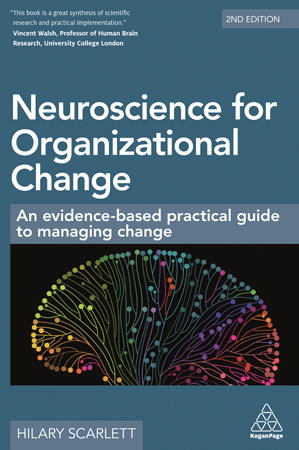This book is a significant addition to any catalogue of practical guides to organisational change. Hilary Scarlett examines the evidence coming from a relatively new branch of life science which, according to Merriam-Webster, “deals with the anatomy, physiology, biochemistry, or molecular biology of nerves and nervous tissue and especially with their relation to behaviour and learning”. Scarlett draws extensively on a wealth of scientific research and delivers a very practical guide to leading and managing organisational change. A stand-alone book on change management it isn’t, but the examination and application of the science provides value by adding to our knowledge and understanding of human behaviour and of organisational change.
The book is in two parts. The first and shorter part deals with neuroscience as a field of study. Thankfully, this section is relatively short but provides necessary context to the second part. This is where the book becomes even more interesting from change practitioner’s standpoint, and it deals with the appliance of the science to change. The author helpfully breaks the guide down into distinct parts, covering performance, the role of leaders and managers, managing emotions, decision-making and bias, communication and storytelling, planning for change, changing behaviour, and planning productivity. In addition, in each chapter, Scarlett provides well-thought out summaries and application guides. Scarlett clearly draws on her own extensive change management experience.
Insofar as the science is concerned, this appears to be empirical and as such much of what the author covers in her book will come across as validation of many practices already used in change management. But there are also plentiful “a-ha” moments as well as some striking challenges to established thinking, such as Maslow’s hierarchy of needs. According to neuroscientific thinking, each level in the hierarchy has the right label, it’s just that the order is incorrectly constructed.
The author’s final chapter is the most generous of all, a synthesis of all the preceding chapters, in which she offers thoughts on applying neuroscience to the organisation.
All in all, this is a highly researched book made both readable and accessible through the author’s ability to relate the science to human behaviour in the context of the workplace. It is also readily applicable, although one would be advised to read the book as a whole first. Although the focus of the book is organisational change, there is also relevance and value in it to the fields of leadership, coaching and communications.
Jim Kennedy, Founder and Director, Metis (People & Organisation) Consulting







